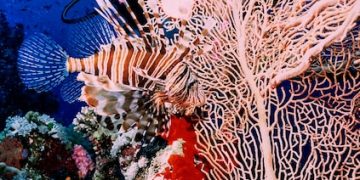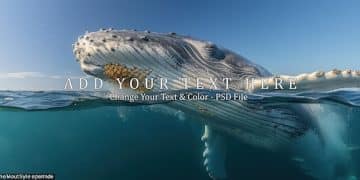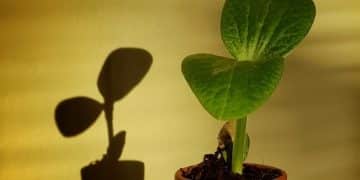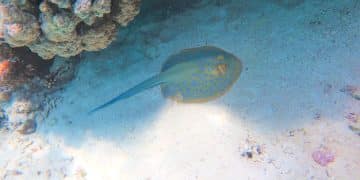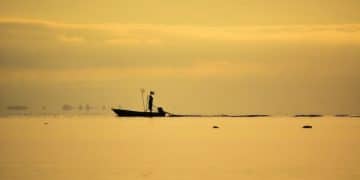Latest Innovations in Sustainable Aquaculture Practices in the US
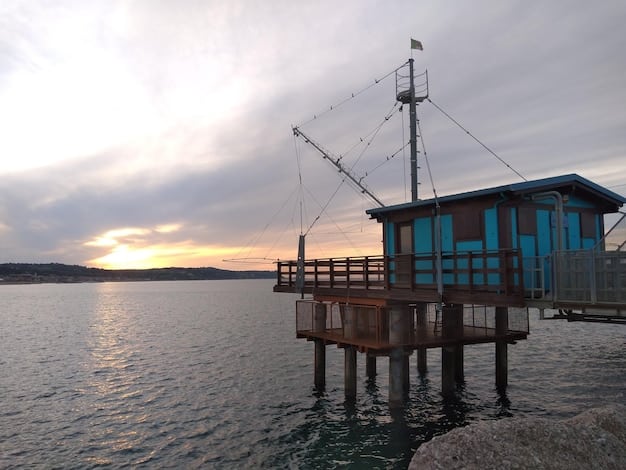
Significant advancements in sustainable aquaculture across the US are leveraging cutting-edge technologies like recirculating aquaculture systems (RAS), offshore farming, and integrated multi-trophic aquaculture (IMTA) to minimize environmental impact, enhance resource efficiency, and meet growing seafood demands responsibly.
In a world increasingly aware of its environmental footprint, the quest for sustainable food sources is paramount. Within this context, aquaculture, the farming of aquatic organisms, plays a crucial role. However, traditional methods often pose environmental challenges. This is where the focus shifts to **What are the Latest Innovations in Sustainable Aquaculture Practices in the US?** These advancements are not merely incremental changes but revolutionary steps toward a more responsible and efficient seafood production system, safeguarding our marine ecosystems for future generations.
Recirculating Aquaculture Systems (RAS): A Game Changer for Land-Based Farming
Recirculating Aquaculture Systems, or RAS, represent a pivotal innovation in sustainable aquaculture by allowing fish farming on land, in a controlled environment. This technology significantly reduces water usage, minimizes waste discharge, and provides biosecurity benefits by isolating farmed species from external pathogens. The ability to locate these farms closer to urban centers also dramatically cuts down on transportation costs and carbon emissions, delivering fresher produce to consumers.
RAS technology functions by continuously filtering and reusing water within the system. This closed-loop approach drastically minimizes the need for freshwater exchange, often reducing it by over 90% compared to traditional flow-through systems. Key components of a typical RAS setup include mechanical filters, biofilters, oxygenation systems, and UV sterilization units, all working in concert to maintain optimal water quality for the aquatic species.
Advanced Filtration and Biofiltration
At the heart of RAS efficiency are its sophisticated filtration processes. Mechanical filters remove solid waste, preventing the accumulation of organic matter that can degrade water quality. Following this, biofilters convert harmful ammonia and nitrites, byproducts of fish metabolism, into less toxic nitrates through a natural biological process involving beneficial bacteria. This multi-layered filtration ensures that the aquatic environment remains pristine for the farmed animals.
- Reduced water consumption: RAS systems reuse up to 99% of their water, drastically lowering freshwater demand compared to open systems.
- Minimized waste discharge: Effluent is highly concentrated, allowing for easier treatment and nutrient recovery, reducing environmental pollution.
- Enhanced biosecurity: Closed systems protect fish from external diseases, parasites, and predators, leading to lower mortality rates and reduced need for antibiotics.
- Optimal growth conditions: Precise control over water temperature, oxygen levels, and other parameters ensures ideal growth conditions and feed conversion ratios.
The application of RAS is expanding beyond traditional finfish. Researchers are now exploring its use for shellfish and even certain types of aquatic plants, opening new avenues for diverse and localized sustainable seafood production. The continuous refinement of filtration technologies, energy efficiency, and automation within RAS facilities promises even greater environmental and economic advantages in the near future, solidifying its role as a cornerstone of sustainable aquaculture in the US.
In essence, RAS technology is not just about farming fish; it’s about farming them smarter, with greater control, less waste, and a significantly smaller ecological footprint, representing a true paradigm shift for the aquaculture industry.
Offshore Aquaculture: Leveraging the Vastness of the Ocean
Moving aquaculture farms further out into the open ocean represents another significant leap towards sustainability in the US. Offshore aquaculture aims to mitigate some of the environmental impacts associated with nearshore or land-based operations, such as localized nutrient loading and potential habitat destruction. By utilizing deeper waters and stronger currents, waste dispersal is naturally enhanced, reducing point source pollution. This approach also opens up vast, unutilized ocean spaces for seafood production, alleviating pressure on wild fish stocks and freshwater resources.
The development of robust and resilient offshore farming structures is critical for success. These structures must withstand harsh ocean conditions, including strong winds, waves, and currents, while ensuring the welfare of farmed species. Innovations in materials science and engineering are enabling the deployment of increasingly durable and efficient offshore cages and platforms.
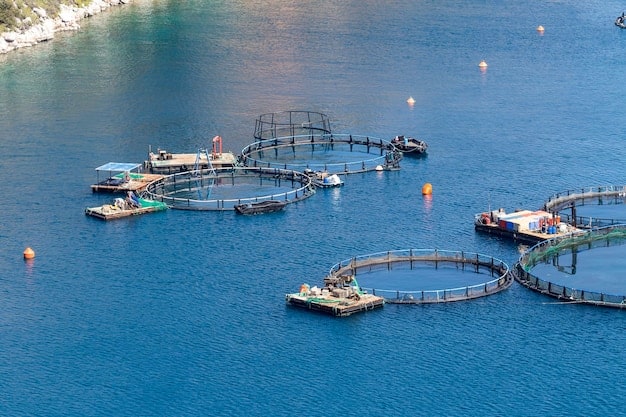
Advanced Cage Design and Materials
Modern offshore cages are designed to be submersible or semi-submersible, protecting fish from surface storms and predators. Materials like high-density polyethylene (HDPE) are favored for their durability, flexibility, and resistance to corrosion and biofouling. These designs also incorporate features for automated feeding, monitoring, and harvesting, reducing the need for constant human intervention and improving operational efficiency.
- Reduced environmental impact: Open ocean currents help disperse waste, minimizing localized nutrient buildup and its effects on benthic ecosystems.
- Greater scale potential: Vast offshore areas offer significant room for expansion, enabling higher production volumes to meet increasing demand.
- Improved fish health: Stronger currents and deeper waters often provide more natural conditions, reducing stress and disease incidence in farmed fish.
- Decreased land-use conflict: Moving farms offshore avoids competition for coastal space with other industries and communities.
Despite its promise, offshore aquaculture presents unique challenges, including the logistical complexities of operating in remote locations, higher capital costs for robust infrastructure, and the need for stricter regulatory oversight to ensure environmental protection. However, ongoing research and investment by both government agencies and private companies are actively addressing these hurdles. Projects funded by entities like the National Oceanic and Atmospheric Administration (NOAA) are exploring optimal siting, technological advancements, and best management practices to ensure the responsible expansion of offshore aquaculture.
With careful planning and continued innovation, offshore aquaculture has the potential to become a cornerstone of sustainable seafood production in the US, producing large quantities of fish in an environmentally sound manner, far from sensitive coastal habitats.
Integrated Multi-Trophic Aquaculture (IMTA): Mimicking Natural Ecosystems
Integrated Multi-Trophic Aquaculture (IMTA) is an innovative approach that mimics natural ecosystems by co-culturing different species from various trophic levels. In essence, the waste products from one farmed species become nutrients for another. This synergistic relationship leads to a more balanced and efficient system, significantly reducing the environmental footprint of aquaculture. For example, fish waste can fertilize seaweed, which in turn purifies the water and provides food for filter-feeding shellfish.
This biological diversification contrasts sharply with traditional monoculture, which often leads to accumulation of waste and localized pollution. IMTA systems include fed organisms (like finfish), extractive organic organisms (like shellfish that feed on uneaten feed and feces), and extractive inorganic organisms (like seaweeds that absorb dissolved inorganic nutrients). The beauty of IMTA lies in its ability to convert potential pollutants into valuable co-products, enhancing the overall economic viability of the farm while improving environmental performance.
Designing Balanced IMTA Systems
The success of an IMTA system hinges on the careful selection and spatial arrangement of compatible species. Researchers are actively studying various combinations to optimize nutrient flow and maximize the recovery of valuable biomass. The goal is to achieve an ecological balance where each component benefits from the others, creating a truly sustainable production cycle.
- Waste reduction and nutrient recycling: Converts aquaculture waste into valuable biomass, minimizing environmental impact and generating additional revenue streams.
- Increased biodiversity: Promotes a more robust and resilient farm ecosystem, reducing the risk of disease outbreaks and enhancing overall ecological health.
- Improved water quality: Extractive species like shellfish and seaweed naturally filter the water, leading to cleaner farm conditions and surrounding environments.
- Diversified product portfolio: Offers a wider range of marketable products, reducing economic risks associated with single-species farming.
The implementation of IMTA in the US is gaining traction, with various pilot projects demonstrating its ecological and economic benefits. From salmon farms integrating kelp and mussels to oyster farms co-culturing with various sea vegetables, the possibilities are diverse. Regulatory frameworks are also evolving to support these complex, multi-species systems, recognizing their potential for sustainable growth within the aquaculture sector.
IMTA is more than just a farming technique; it’s an ecological philosophy applied to aquaculture, demonstrating how human activity can be integrated with natural processes to achieve both productivity and environmental stewardship, paving the way for a truly restorative aquaculture industry.
Aquaponics and Mariculture: Bridging Water and Land Ecologies
Aquaponics and mariculture represent two distinct yet complementary innovations that highlight the convergence of different agricultural practices to enhance sustainability. Aquaponics combines aquaculture with hydroponics, the growing of plants in water. This integrated system allows fish waste to fertilize plants, while the plants filter the water for the fish, creating a symbiotic loop that significantly reduces water usage and eliminates the need for chemical fertilizers.
Mariculture, specifically the cultivation of marine organisms in seawater, is advancing rapidly with new technologies that improve efficiency and reduce environmental burdens. This often involves the use of specialized systems for species like shrimp, finfish, and shellfish in coastal or open-ocean environments, focusing on minimizing escapes and managing waste effectively through innovation.
Innovations in Integrated Systems
For aquaponics, innovations focus on efficient nutrient cycling, energy-saving designs, and the development of systems suitable for diverse climates and scales, from small backyard setups to large commercial operations. Key advancements include improved biofilter designs, optimized plant and fish species pairings, and automated monitoring systems that ensure stable environmental conditions.
In mariculture, the emphasis is on developing durable, environmentally sound containment systems, improving feed efficiency, and implementing disease prevention strategies that reduce antibiotic use. The advent of advanced sensors and data analytics allows for real-time monitoring of water quality, fish health, and growth rates, enabling proactive management and optimized production cycles.
- Water conservation: Aquaponics uses significantly less water than traditional agriculture or aquaculture by recycling it continuously.
- Reduced chemical inputs: Eliminates the need for synthetic fertilizers and minimizes antibiotic use due to natural filtration and improved health.
- Year-round production: Controlled environments in aquaponics allow for consistent production regardless of external climatic conditions.
- Resource efficiency in mariculture: Innovations in feed formulation and cage design reduce environmental impact and improve economic returns.
The growth of aquaponics facilities, particularly in urban areas, is a testament to its potential to provide fresh, local produce and seafood with a minimal footprint. Similarly, responsible mariculture practices are crucial for the sustainable growth of coastal economies, providing high-quality seafood while minimizing impacts on sensitive marine ecosystems. Both fields are seeing increased research and development, aiming to optimize system performance and expand their applicability, offering diverse pathways to sustainable food production.
By blending the best aspects of aquatic and terrestrial farming, and by refining marine cultivation, these innovations are driving significant progress towards food security and environmental responsibility in the US.
Genetics and Feed Innovation: Enhancing Efficiency and Sustainability
Genetic advancements and innovations in aquatic feed are critical pillars supporting the sustainable growth of aquaculture in the US. Selective breeding programs aim to develop aquatic species that exhibit faster growth rates, higher disease resistance, better feed conversion efficiency, and improved flesh quality. These genetic improvements translate directly into more productive farms that require fewer resources and have a lower environmental impact, reducing pressure on wild fish stocks and minimizing the use of antibiotics.
Parallel to genetic improvements, the development of sustainable aquafeeds is paramount. Traditional feeds often rely heavily on fishmeal and fish oil derived from wild-caught forage fish, which can deplete ocean resources. Innovations in feed formulation are focused on replacing these marine ingredients with sustainable alternatives, such as plant-based proteins, insect meal, algal oils, and microbial biomass.
Sustainable Feed Alternatives and Nutrigenomics
The quest for truly sustainable feeds extends beyond simple substitution. Researchers are delving into nutrigenomics, studying how dietary components interact with an organism’s genes to influence growth, health, and disease resistance. This allows for the development of precisely formulated feeds that meet the specific nutritional requirements of farmed species at different life stages, maximizing efficiency and minimizing waste.
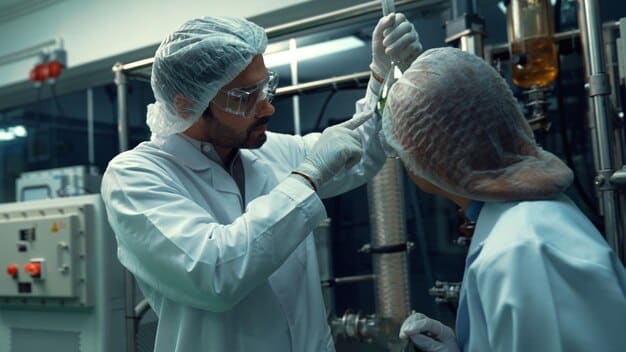
- Improved growth rates: Genetically selected species grow faster, reducing the time to market and consumption of resources.
- Enhanced disease resistance: Reduces the reliance on antibiotics and minimizes economic losses due to disease outbreaks.
- Better feed conversion ratio: Fish convert feed into biomass more efficiently, reducing the amount of feed needed and waste produced.
- Reduced reliance on wild fish: Sustainable feeds lessen the demand for marine ingredients, preserving wild fish populations and marine ecosystems.
Several groundbreaking projects in the US are focused on commercializing these alternative feed ingredients. For example, companies are scaling up the production of insect-based proteins, while others are developing microalgae as a rich source of omega-3 fatty acids, offering a sustainable substitute for fish oil. These efforts are not only transforming the aquaculture feed industry but also creating new agricultural value chains.
The synergy between genetic selection and innovative feed strategies is laying the groundwork for an aquaculture industry that is not only productive but also environmentally benign, ensuring that future seafood production can meet global demand without compromising the health of our oceans.
Advanced Monitoring and Data Analytics: Precision Aquaculture
The integration of advanced monitoring technologies and data analytics, often termed “precision aquaculture,” is revolutionizing how aquaculture farms operate in the US. By leveraging sensors, cameras, artificial intelligence (AI), and machine learning (ML), farmers can gain unprecedented insights into the health, growth, and environmental conditions of their aquatic populations. This real-time data empowers them to make informed decisions swiftly, optimizing resource use, improving fish welfare, and enhancing overall farm productivity.
These technologies allow for continuous surveillance of critical parameters such as water temperature, oxygen levels, pH, salinity, and ammonia concentrations. Beyond environmental monitoring, sophisticated imaging systems can track individual fish growth, detect early signs of disease, and even count biomass accurately. This level of detail was previously unimaginable and marks a significant departure from traditional, often reactive, farming methods.
AI-Powered Management and Automation
AI and machine learning algorithms analyze the vast amounts of data collected by sensors, identifying patterns and predicting potential issues before they escalate. This predictive capability enables proactive adjustments to feeding regimes, water quality management, and disease prevention protocols. Automation, driven by these insights, can control aspects like feed delivery, lighting, and water flow, further optimizing operations and reducing labor costs.
- Real-time environmental monitoring: Provides immediate data on water parameters, ensuring optimal conditions for fish health and growth.
- Individual fish tracking: Enables precise monitoring of growth rates and early detection of diseases or stress in individual animals.
- Optimized resource utilization: AI-driven insights lead to more efficient use of feed, water, and energy, reducing operational costs and environmental impact.
- Enhanced biosecurity and welfare: Early detection of issues allows for rapid intervention, improving fish health outcomes and minimizing losses.
The adoption of precision aquaculture solutions is accelerating across various farming systems, from large-scale offshore operations to compact RAS facilities. Startups and established technology companies are developing innovative hardware and software solutions tailored to the unique challenges of aquatic farming. For example, underwater drones equipped with sensors and cameras can autonomously inspect nets and tanks, while AI-powered feeding systems prevent overfeeding, a major source of waste and pollution.
This technological wave is transforming aquaculture into a high-tech industry, making it more predictable, efficient, and significantly more sustainable. The ability to monitor, analyze, and react with such precision is key to overcoming many of the historical challenges associated with aquatic food production, paving the way for a truly sustainable and productive aquaculture sector in the US.
Policy and Collaboration: Driving Sustainable Aquaculture Forward
While technological innovations are crucial, strong policy frameworks and robust collaboration among stakeholders are equally vital for the advancement of sustainable aquaculture in the US. Effective policies provide the necessary regulatory certainty, incentivize adoption of best practices, and ensure environmental protection. Collaborative efforts, meanwhile, foster knowledge exchange, pool resources, and build consensus among industry players, researchers, government agencies, and environmental groups.
The US government, through agencies like NOAA and the USDA, plays a significant role in promoting sustainable aquaculture through funding for research, development of best management practices, and streamlined permitting processes. These efforts are aimed at creating an enabling environment for responsible growth, ensuring that aquaculture expansion is aligned with national environmental goals and food security objectives.
Multi-Stakeholder Partnerships and Regulatory Modernization
The establishment of multi-stakeholder partnerships is fundamental. These collaborations bring together diverse perspectives to address complex challenges, from developing industry standards for sustainability to exploring market opportunities for sustainably farmed products. Public-private partnerships are particularly effective in accelerating the translation of research into practical, scalable solutions.
- Regulatory clarity: Streamlined and consistent permitting processes encourage investment and responsible expansion of aquaculture operations.
- Research funding and dissemination: Government and private funding support the development and adoption of new sustainable technologies and practices.
- Market incentives: Consumer demand for sustainable seafood drives industry adoption of environmentally friendly farming methods.
- International cooperation: Sharing best practices and research findings with global partners accelerates progress in sustainable aquaculture worldwide.
Efforts to modernize regulatory frameworks are ongoing, aiming to balance environmental protection with economic development. This includes developing clear guidelines for siting new farms, managing waste, and ensuring fish welfare. Furthermore, educational initiatives are crucial for raising public awareness about the benefits of sustainable aquaculture and for training the next generation of aquaculture professionals.
The future of sustainable aquaculture in the US depends not only on scientific breakthroughs but also on the collective commitment of all stakeholders to work together towards a common vision. Through forward-thinking policies and collaborative actions, the US can solidify its position as a leader in environmentally responsible seafood production, contributing significantly to global food security while safeguarding marine ecosystems for future generations.
| Key Innovation | Brief Description |
|---|---|
| 🔄 RAS Technology | Land-based systems that recycle water, reducing usage and waste discharge. |
| 🌊 Offshore Farming | Cultivating fish in open ocean waters, enhancing waste dispersal and minimizing localized impact. |
| 🌿 IMTA Systems | Co-culturing different species where one’s waste feeds another, mimicking natural cycles. |
| 🔬 Precision Aquaculture | Utilizing advanced sensors and AI for real-time monitoring and optimized farm management. |
Frequently Asked Questions about Sustainable Aquaculture in the US
▼
RAS offers significant environmental benefits by drastically reducing water consumption through continuous recycling (up to 99%). It also minimizes waste discharge by concentrating effluents for easier treatment and nutrient recovery, preventing pollution. Furthermore, its controlled environment enhances biosecurity, lessening the need for antibiotics and chemical treatments.
▼
Offshore aquaculture mitigates concerns like localized nutrient pollution and habitat destruction by moving farms to deeper waters with stronger currents. This natural dispersal helps assimilate waste more effectively. It also frees up valuable coastal land and reduces pressure on wild fish stocks by expanding production into vast ocean spaces, providing a cleaner environment for farmed species.
▼
IMTA is a system where different species from various trophic levels are co-cultured, mimicking natural ecosystems. For instance, fish waste becomes nutrients for seaweed or shellfish. This approach promotes nutrient recycling, reduces waste, improves water quality naturally, and diversifies the farm’s output, creating a more balanced and environmentally friendly production cycle.
▼
Genetic advancements create fish with better growth rates, disease resistance, and feed conversion efficiency, reducing resource use and antibiotic needs. Feed innovation focuses on replacing wild-caught fishmeal/oil with sustainable alternatives like plant-based proteins, insect meal, and algae. Together, they enhance efficiency, cut down on inputs, and decrease environmental impact, making aquaculture more sustainable.
▼
Precision aquaculture uses sensors, AI, and machine learning for real-time monitoring of water quality, fish health, and growth. This data allows farmers to optimize feeding, manage water conditions proactively, and detect diseases early. It leads to more efficient resource utilization, improved fish welfare, and higher productivity, transforming aquaculture into a data-driven, highly controlled, and sustainable industry.
The Path Forward for Sustainable Aquaculture in the US
The journey towards a truly sustainable aquaculture industry in the US is marked by continuous innovation, scientific advancement, and a growing commitment to environmental stewardship. From the controlled, land-based environments of Recirculating Aquaculture Systems to the vast, open expanses leveraged by offshore farms, and the ecological harmony achieved through IMTA, the sector is transforming rapidly. These technological leaps, coupled with critical progress in genetics, feed development, and precision monitoring, are redefining what is possible in aquatic food production. Importantly, the role of supportive policies and strong collaboration among all stakeholders cannot be overstated in driving these innovations from concept to widespread implementation. As the US strives to meet increasing seafood demand while preserving its invaluable marine resources, the ongoing evolution of sustainable aquaculture practices stands as a beacon of hope, promising a future where food security and ecological health can coexist harmoniously.
